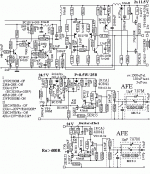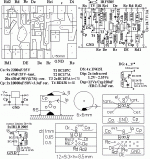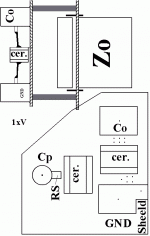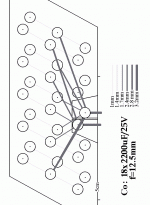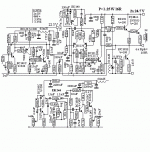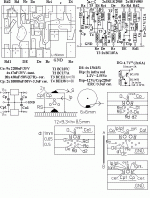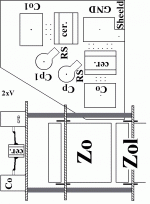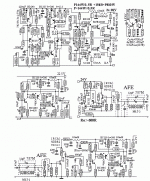Gateway to professional quality: headphone amplifiers.
Attachments
Whoaaa....yet another pointless thread.
All your threads are very good in showing unreadable schematics designed 30+ years ago 🙂
What do you try to say , ask or show with these threads? I think even you don't know.
Keep up with the good work! 😡
Regards!
All your threads are very good in showing unreadable schematics designed 30+ years ago 🙂
What do you try to say , ask or show with these threads? I think even you don't know.
Keep up with the good work! 😡
Regards!
New techniques to enhance the audio is not quite good, because they are classic design principles that do not change -I showed the good things and for complete information nothing I have to hide and whether we can be afraid?
Perhaps if you render these designs in LT spice or free drafting program, using modern components, people may read them and consider your views.
Last edited:
What is normally well it is well.
Even from the very god of schemes are not good if they are bad applies.
Even from the very god of schemes are not good if they are bad applies.
There is nothing "well" about unobtainable parts, obscure drawings or guitar effects
in headphone amplifiers.
We can only comment on what we see. The glory of 1970s audio engineering
does not travel by internet, so we must see how it differs from what we consider
the best possible for us in 2012. We don't rely on hard-wire assembly any more,
so there is little but schematic diagrams to compare.
To appreciate anything abstract, we must compare, so drafting schematics in
standard format or spice programs helps to do this for everyone.
in headphone amplifiers.
We can only comment on what we see. The glory of 1970s audio engineering
does not travel by internet, so we must see how it differs from what we consider
the best possible for us in 2012. We don't rely on hard-wire assembly any more,
so there is little but schematic diagrams to compare.
To appreciate anything abstract, we must compare, so drafting schematics in
standard format or spice programs helps to do this for everyone.
Who looks for and checks it knows what might be best.
Most people have not learned the power precise application, and appropriate measurements of transistors, for the normal projects.
Most people have not learned the power precise application, and appropriate measurements of transistors, for the normal projects.
Who looks for and checks it knows what might be best.
Most people have not learned the power precise application, and appropriate measurements of transistors, for the normal projects.
this is a nonsensical generalization and I dont just mean your electronic translator. your schematics are indecipherable and full of parts that are not available to buy, how do you suppose this is good engineering?
we have headphone amps (in the headphone forum....) that defy the most modern instruments to measure them. maybe true not everything is in the measurements, but we can bet it beats the headphone amp from the 70's when i'm sorry, but the headphone amps were mostly terribly performing afterthoughts. Another thing is, we can bet that your yesteryear schematic was designed for yesteryear's headphones, which were VERY different.
appreciate the effort, but lets face it regurgitating old work without even making the effort to make it legible in today's context to todays engineers/builders/hobbiests; doesnt take that much work
Last edited:
Audio business never use ready-made things produced at the factory.
Therefore, all audio diagrams are not the best and only ridiculously easy to manufacture.
Only small businesses use audio stuff factory production.
Therefore, all audio diagrams are not the best and only ridiculously easy to manufacture.
Only small businesses use audio stuff factory production.
Meaning big companies don't use factory production? Where is the production then?Only small businesses use audio stuff factory production.
I do not write about the production of these things, but about who uses the audio stuff for your own business:CD, audio music recordings, audio or things done to themselves by companies producing transistors.
Audio business never use ready-made things produced at the factory.
Therefore, all audio diagrams are not the best and only ridiculously easy to manufacture.
Only small businesses use audio stuff factory production.
I really have no idea what you are on about now
No one taught people and not teach the normal audio technica, if there are people who still closes the door of professional quality.
Triumph of form over content, now just a set of complementary power JFET, a good driver to them, and the number of active elements located from 3 to 10 on the channel gain and the gain's full.
We have a twenty-first century rather than the 70 th , XX century.
We have a twenty-first century rather than the 70 th , XX century.
If "qusp" laughed the more I think it is a friend of true Dracula from Transylvania and in the history of the same from city Stalowa Wola -Robert Wojciechowski
You are easily impressed by images such as an Avatar, adorn, Don't be fooled, even as few of us will be fooled by sentimental attachments to old audio technology.
I recognise many components and some topologies in those schematics from the early silicon era when dual-gate Mosfets were used everywhere they could be applied. They were a short-lived novelty outside RF application and just one feature of these schematics that have fallen into disuse, replaced by dependable, lower noise and distortion opamps, Jfets and, of course, DSP.
It may be interesting to look at these historically but "professional" would not be an apt description today or even 30 years ago, whatever our subjective preference in technology may be.
I recognise many components and some topologies in those schematics from the early silicon era when dual-gate Mosfets were used everywhere they could be applied. They were a short-lived novelty outside RF application and just one feature of these schematics that have fallen into disuse, replaced by dependable, lower noise and distortion opamps, Jfets and, of course, DSP.
It may be interesting to look at these historically but "professional" would not be an apt description today or even 30 years ago, whatever our subjective preference in technology may be.
- Status
- Not open for further replies.
- Home
- Amplifiers
- Solid State
- Gateway to professional quality: headphone amplifiers
